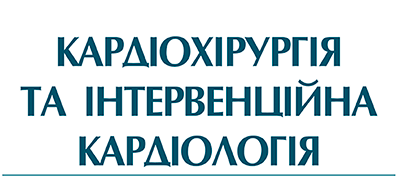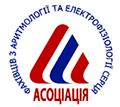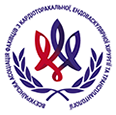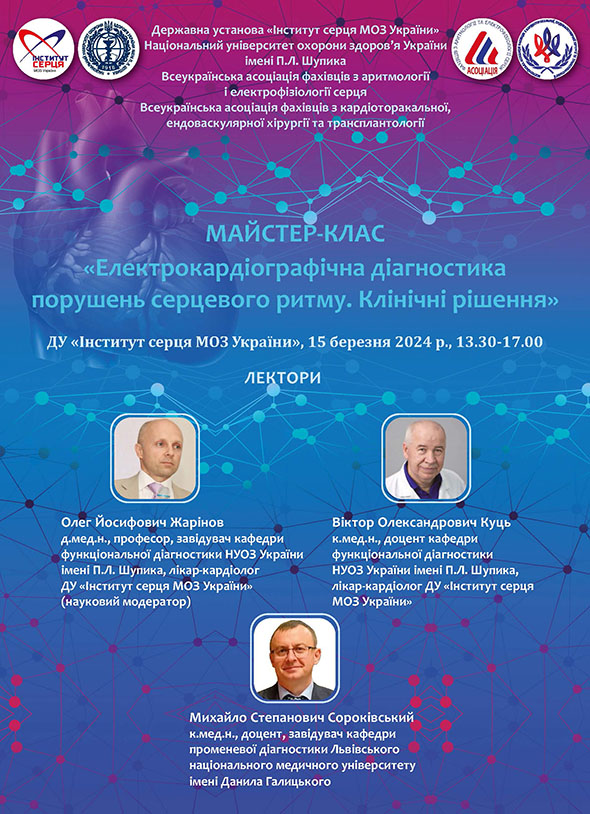Синдром Вольфа – Паркинсона – Уайта и фибрилляция предсердий
Н.Т. Ватутин, Н.В. Калинкина, А.Э. Дегтярёва, О.К. Кашанская
Література
1. Ардашев В.Н., Стеклов В.И. Лечение нарушений сердечного ритма.– М.: Медпрактика.– 1998.– С. 13–14.
2. Белялов Ф.И. Аритмии сердца.– Иркутск: РИО ИГИУВа.– 2011.– C. 131–154.
3. Бобров В.А., Жаринов О.И., Куць В.А. и др. Диагностика синдромов преждевременного возбуждения желудочков // Укр. кардіол. журн.– 2009.– № 4.– С. 98–108.
4. Бойцов С.А., Подлесов А.М. Постоянная форма фибрилляции предсердий // Сердце.– 2002.– № 2.– С. 76–82.
5. Бокерия Л.А., Оганов Р.Г., Ревишвили А.Ш. Рекомендации по лечению больных с нарушением ритма сердца.– М.: РАМН, 2006.– С. 127–128.
6. Ватутин Н.Т., Калинкина Н.В. Синдром преждевременного возбуждения желудочков // Синдромы в кардиологии.– Донецк: Каштан, 2010.– С. 146–147.
7. Гусак В.К., Кузнецов А.С., Комиссаров С.И. и др. Хирургическое лечение больных с WPW-синдромом в сочетании с фибрилляцией предсердий // Укр. мед. часопис.– 2001.– № 5 (25).– С. 135–138.
8. Диагностика и лечение фибрилляции предсердий. Российские рекомендации, разработанные Комитетом экспертов Всероссийского научного общества кардиологов.– М., 2005.– C. 1–28.
9. Ковалев Д.В., Скибицкий В.В., Курзанов А.Н. Случай пароксизмальной фибрилляции предсердий на фоне синдрома Вольфа – Паркинсона – Уайта // Вестник Городской больницы.– 2010 – № 3.– C. 1–8.
10. Кушаковский М.С. Аритмии сердца.– СПб: Гиппократ, 1998.– 544 с.
11. Локшин С.Л., Правосудович С.А., Дзяк В.Г. О возможности устранения мерцательной аритмии у пациентов с синдромом WPW // Вестник аритмологии.– 1998.– № 7.– С. 36–41.
12. Миклашевич И.М., Школьникова М.А., Сыркин А.Л. и др. Естественное течение суправентрикулярных тахикардий, манифестировавших в детском возрасте // Вестник аритмологии.– 2002.– № 29.– С. 60–65.
13. Недоступ А.В., Благова О.В. Современная тактика медикаментозной урежающей терапии при мерцательной аритмии // Рус. мед. журн.– 2003.– № 21.– C. 1168–1172.
14. Фролов А.И., Зотов С.Ю., Зинченко Ю.В. Возрастные отличия электрофизиологических параметров у пациентов с синдромом Вольфа–Паркинсона–Уайта // Укр. мед. журн.– 2001.– № 2.– C. 9–15.
15. Шилов А.М., Мельник М.В., Осия А.О. и др. Пато физиология и принципы лечения фибрилляции предсердий // Рус. мед. журн.– 2011.– № 14.– С. 877–884.
16. ACC/AHA/ESC Guidelines for the Management of Patients With Atrial Fibrillation – Executive Summary // Eur. Heart J.– 2006.– Vol. 27.– P. 1979–2030.
17. Adlam D., Azeem T. Ventricular fibrillation during electrical cardioversion of pre-excited atrial fibrillation // Postgrad. Med. J.– 2003.– Vol. 79.– Р. 297–299.
18. Aronow W.S. Treatment of atrial fibrillation and atrial flutter. Part II // Cardiol. Rev.– 2008.– Vol. 16.– P. 230–239.
19. Beck O.A., Hochrein H. Indications and risks of anti-arrhythmia treatment with propafenone // Dutsch Med. Wochenschr.– 1978.– Vol. 103.– Р. 1261–1265.
20. Blanc J.J., Boschat J., Ollivier J.P. Penther P. Effects of oral sotalol on the conduction of accessory atrioventricular pathways // Arch. Mal. Coeur. Vaiss.– 1985.– Vol. 78.– Р. 1097–1102.
21. Bodalski R., Maryniak A., Walczak F. et al. Glass of water or ablation? Еpisodes of malignant atrial tachyarrhythmias during swimming in a lake in a woman with overt Wolff–Parkinson–White syndrome and benign palpitations for several decades of life // Kardiol. Pol.– 2008.– Vol. 66.– P. 1346–1349.
22. Brembilla-Perrot B., Chometon F., Groben L. et al. Are the results of electrophysiological study different in patients with a pre-excitation syndrome, with and without syncope? // Europace.– 2008.– Vol. 10.– Р. 175–180.
23. Brembilla-Perrot B., Holban I., Houriez P. et al. Does patient age influence the indications for investigating asympatomatic Wolff–Parkinson–White syndrome? // Arch. Mal. Coeur. Vaiss.– 2000.– Vol. 93.– Р. 1523–1527.
24. Brembilla-Perrot B., Popescu I., Huttin O. et al. Risk of atrial fibrillation according to the initial presentation of a preexcitation syndrome // Int. J. Cardiol.– 2011.– Р. 134–137.
25. Burashnikov A., Belardinelli L., Antzelevitch C. Atrial-selective sodium channel block strategy to suppress atrial fibrillation. Ranolazine versus propafenone // J. Pharmacol. Exp. Ther.– 2011.– C. 134–139.
26. Cagli K.E., Topaloglu S., Aras D. et al. Evaluation of atrial vulnerability immediately after radiofrequency catheter ablation of accessory pathway in patients with Wolff–Parkinson–White syndrome // J. Interv. Card. Electrophysiol.– 2009.– Vol. 26.– Р. 217–224.
27. Centurión O.A., Shimizu A., Isomoto S., Konoe A. Mechanisms for the genesis of paroxysmal atrial fibrillation in the Wolff–Parkinson–White syndrome: intrinsic atrial muscle vulnerability vs. electrophysiological properties of the accessory pathway // Europace.– 2008.– Vol. 10.– Р. 294–302.
28. Chillou C., Rodriguez L.M., Schlapfer J. et al. Clinical characteristics and electrophysiologic properties of atrioventricular accessory pathways: importance of the accessory pathway location // J. Amer. Coll. Cardiol.– 1992.– Vol. 20.– Р. 666–671.
29. Conover M.B. Diagnosis and management of arrhythmias associated with Wolff–Parkinson–White syndrome // Crit. Care Nurse.– 1994.– Vol.14.– Р. 30–39.
30. Emkanjoo Z., Ebadi K., Sharifi M. et al. Electrophysiological characteristics of orthodromic reentrant tachycardia in patients with Wolf–Parkinson–White syndrome and atrial fibrillation // Int. J. Cardiol.– 2010.– Vol. 12.– P. 196–198.
31. Erdem A., Madak, N., Yilmaz A. et al. Development of malignant ventricular arrhythmias in a young male with WPW pattern // Indian Pacing Electrophysiol. J.– 2010.– Vol. 10.– Р. 195–200.
32. Fazekas T.A. concise history of the Wolff–Parkinson–White syndrome // Orvostort Kozl.– 2007.– Vol. 51.– Р. 5–22.
33. Fengler B.T., Brady W.J., Plautz C.U. Atrial fibrillation in the Wolff–Parkinson–White syndrome: ECG recognition and treatment in the ED // Amer. J. Emerg. Med.– 2007.– Vol. 25.– Р. 576–583.
34. Gambhir D.S., Bhargava M., Arora R., Khalilullah M. Electrophysiologic effects and therapeutic efficacy of intravenous flecainide for termination of paroxysmal supraventricular tachycardia // Indian Heart J.– 1995.– Р. 237–243.
35. Guidelines for the management of atrial fibrillation. The Task Force for the Management of Atrial Fibrillation of the European Society of Cardiology // Eur. Heart J.– 2010.– Vol. 31.– P. 2369–2429.
36. Haigney M.C. Ablation should not be first-line therapy for the treatment of atrial fibrillation // Expert Rev. Cardiovasc. Ther.– 2007.– Vol. 5.– P. 673–679.
37. Huttin O., Brembilla-Perrot B. Relationships between age and accessory pathway location in Wolff-Parkinson-White syndrome // Ann. Cardiol. Angeiol. (Paris).– 2008.– Vol. 57.– Р. 225–230.
38. Jurkovicova O. Special character of atrial paroxysmal fibrillation in coincidence with WPW syndrome // Bratisl. Lek. Listy.– 2001.– Vol. 102.– Р. 424–426.
39. Knorre G.H. The earliest published electrocardiogram showing ventricular preexcitation // Pacing Clin. Electrophysiol.– 2005.– Vol. 28.– Р. 228–230.
40. Knorre G.H., Ismer B. Concealed accessory pathways: Historical notes // Herzschrittmacherther Elektrophysiol.– 2010.– Vol. 21.– Р. 71–76.
41. Lee P.C., Hwang B., Chen Y.J. et al. Electrophysiologic characteristics and radiofrequency catheter ablation in children with Wolff–Parkinson–White syndrome // Pacing Clin. Electrophysiol.– 2006.– Vol. 29.– Р. 490–495.
42. Li P. Electrophysiological properties of atrial fibrillation with WPW syndrome and the role of procainamide in conversion // Zhonghua Xin Xue Guan Bing Za Zhi. – 1991.– Vol. 65.– P. 65–66.
43. Lip G.Y., Apostolakis S. Atrial fibrillation (acute onset) // Clin. Evid. (online).– 2011.– N 15.– P. 0210.
44. Liu W., Liu G., Hu D. et al. Familial Wolff–Parkinson–White syndrome is linked to the loci on chromosome 7q3 // Chin. Med. J.– 2003.– Vol. 115.– Р. 1733–1735.
45. Luderitz B. WPW syndrome: the ‘Rosetta stone’ of rhythmology. The history of the Rosetta stone // Europace.–2009.– Vol. 11.– Р. 285–288.
46. Madrid A.H., Moro C., Marin Huerta E.M. et al. Atrial fibrillation in Wolff–Parkinson–White syndrome: reversal of isoproterenol effects by sotalol // Pacing Clin. Electrophysiol.– 1992.– Vol. 15.– P. 2111–2115.
47. Mah D., Miyake C., Clegg R. et al. Epicardial left atrial appendage and biatrial appendage accessory pathways // Heart Rhythm.– 2010.– Vol. 7.– P. 1740–1745
48. Manurung D., Yamin M. Wolff–Parkinson–White syndrome presented with broad QRS complex tachycardia // Acta Med. Indones.– 2007.– Vol. 39.– Р. 33–35.
49. Mujovic N., Grujic M., Mrdja S. et al. Recurrence of atrial fibrillation after successful radiofrequency catheter ablation of accessory pathway in patients with Wolff–Parkinson–White syndrome // Srp. Arh. Celok. Lek.– 2010.– Vol. 138.– P. 170–176.
50. Nielsen T.S., Dalager S., Larsen M.K. et al. Overlooked Wolff–Parkinson–White syndrome // Ugeskr Laeger.– 2010.– Vol. 172.– P. 2521–2522.
51. Nouira S., Ouarda F., Charfeddine C. et al. Clinical and genetic investigation of pediatric cases of Wolff–Parkinson–White syndrome in Tunisian families // Heart Lung.– 2010.– Vol. 39 – Р. 432–436.
52. Orczykowski M., Szumowski L., Szufladowicz E. et al. Sotalol prevents atrio-ventricular tachycardia but not atrial fibrillation with rapid ventricular response in a patient with WPW syndrome // Kardiol. Pol.– 2008.– Vol. 66.– Р. 800–804.
53. Rosner M.H., Brady W.J. Jr., Kefer M.P., Martin M.L. Electrocardiography in the patient with the Wolff–Parkinson–White syndrome: diagnostic and initial therapeutic issues // Amer. J. Emerg. Med.– 1999.– Vol. 17.– Р. 705–714.
54. Simonian S.M., Lotfipour S., Wall C. et al. Challenging the superiority of amiodarone for rate control in Wolff–Parkinson–White and atrial fibrillation // Intern. Emerg. Med.– 2010 – Vol 5.– P. 421–426.
55. Schaer B.A., Maurer A., Sticherling C. et al. Routine echocardiography after radiofrequency ablation: to flog a dead horse? // Europace.– 2009.– Vol. 11 – Р. 155–157.
56. Scheinman M.M. History of Wolff–Parkinson–White syndrome // Pacing Clin. Electrophysiol.– 2005.– Vol. 28.– Р. 152–156.
57. Schwaab B., Katalinic A., Boge U.M. et al. Quinidine for pharmacological cardioversion of atrial fibrillation: a retrospective analysis in 501 consecutive patients // Ann. Noninvasive Electrocardiol.– 2009.– Vol.14.– Р. 128–136.
58. Schwieler J.H., Zlochiver S, Pandit S.V. et al. Reentry in an accessory atrioventricular pathway as a trigger for atrial fibrillation initiation in manifest Wolff–Parkinson–White syndrome: a matter of reflection? // Heart Rhythm.– 2008.– Vol. 5.– Р. 1238–1247.
59. Sethi K.K., Dhall A., Chadha D.S. et al. WPW and preexcitation syndromes // J. Assoc. Physicians India.– 2007.– Vol. 15.– P. 10–15.
60. Shafquat A., Imdad A., Khalid S. et al. Cardiac electrophysiology studies and ablations for treatment of supraventricular arrhythmias-an initial experience from Karachi // J. Pak. Med. Assoc.– 2011.– Vol. 61.– P. 173–175.
61. Shapira A.R. Catheter ablation of supraventricular arrhythmias and atrial fibrillation // Am Fam Physician.– 2009.– Vol. 80.– Р. 1089–1094.
62. Shimizu W., Ohe T., Kurita T. et al. Effects of a combination of disopyramide and mexiletine on the anterograde accessory pathway conduction in patients with Wolff–Parkinson–White syndrome // Eur. Heart J.– 1992.– Vol. 13.– Р. 261–268.
63. Sugi K, Nakae T. Preexcitation syndrome // Nippon Rinsho.– 2002.– Vol. 60.– Р. 1395–1400.
64. Szumowski Ł., Walczak F., Urbanek P. et al. Risk factors of atrial fibrillation in patients with Wolff–Parkinson–White syndrome // Kardiol. Pol.– 2004.– Vol. 60.– Р. 206–216.
65. Tijunelis M.A., Herbert M.E. Myth: Intravenous amiodarone is safe in patients with atrial fibrillation and Wolff–Parkinson–White syndrome in the emergency department // Can. J.Emerg. Med.– 2005.– Vol. 7 – P. 262–265.
66. Turagam M.K., Velagapudi P., Kocheril A.G. Atrial fibrillation in athletes // Amer. J. Cardiol.– 2010.– Р. 172–174.
67. Vignati G., Balla E., Mauri L. et al. Clinical and electrophysiologic evolution of the Wolff–Parkinson–White syndrome in children: impact on approaches to management // Cardiol. Young.– 2000.– Vol. 10.– Р. 303–306.
68. Zhang Y., Wang L. Atrial vulnerability is a major mechanism of paroxysmal atrial fibrillation in patients with Wolff–Parkinson–White syndrome // Med. Hypotheses.– 2006.– Vol. 7.– Р. 1345–1347.
| [PDF] | [Зміст журналу] |












